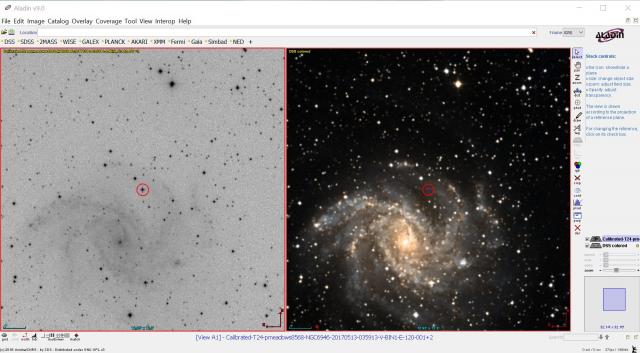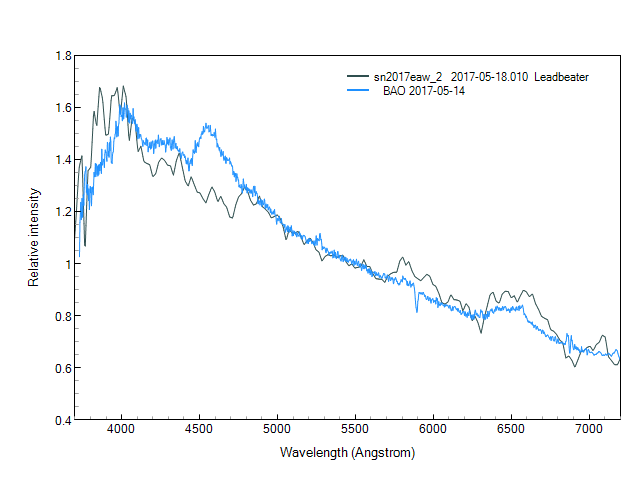› Forums › Spectroscopy › Bright possible supernova in NGC6946
- This topic has 4 replies, 3 voices, and was last updated 8 years, 7 months ago by
 Robin Leadbeater.
Robin Leadbeater.
-
AuthorPosts
-
14 May 2017 at 11:03 am #573749
 Robin LeadbeaterParticipant
Robin LeadbeaterParticipantmag 12.8. Fire up your ALPYs !
Robin
——————————————————————————
AT 2017eaw in NGC 6946 (SN:)
Patrick Wiggins, Tooele, UT, USA, reports his discovery
of a possible supernova (mag about 12.8) on an
unfiltered CCD frame taken 2017 May 14.2383 UT using a
0.35-m f/5.5 reflector near Erda, UT, USA. The new
object is located at
R.A. 20h34m44.24s, Decl. +60°11’35.9” (equinox 2000.0),
about 153” NW of the center of NGC 6946. The discovery
image was posted temporarily at URL
http://users.wirelessbeehive.com/~paw/ngc6946-1.jpg
Wiggins notes that nothing was visible at this position
on an image taken on May 12.http://www.cbat.eps.harvard.edu/unconf/followups/J20344424+6011359.html
AT 2017eaw: https://wis-tns.weizmann.ac.il/object/2017eaw
Clear skies,
Patrick Schmeer————————————
Posted by: Patrick Schmeer
——————————————————————————–
Visit the BAA Variable Star Section web site at…http://www.britastro.org/vss/
——————————————–14 May 2017 at 5:43 pm #578211 Peter MeadowsParticipant
Peter MeadowsParticipantThe attached image shows NGC 6946 acquired on 2017 May 14 at 11:07 UT using iTelescope T24 in California (the average of 3 x 120s exposures) and a comparison DSS image (using Aladin v9.0). The cross and red circle shows the new object (not visible in the DSS image). A larger version of the image is attached.
Astrometrica gives a magnitude of V=13.1 and position RA 20 34 44.24, Dec +60 11 36.1 (J2000) for the new object.
 15 May 2017 at 10:00 am #578213
15 May 2017 at 10:00 am #578213 Andrew RobertsonParticipant
Andrew RobertsonParticipantI managed a brief 5 minute visual view of it last night in my 12” F5 ultra-portable dob from Norfolk. It had been clear all evening and forecast to be clear most of the night but with a bit of cloud coming over early on. Issues were; Nautical dark commencing at 22:25 hrs, astronomical dark at 23:58 hrs and a 86% mon rising at 23:48 hrs. I decided about 23:30 hrs would be about the best time to get on it and had the scope set up by 22:30 hrs in preparation doing a few lollipops (M13, M5, M92 etc.) as a warm up. However shortly before 11pm I saw a cloud front slowly moving over from the SSW so thought I ‘d best have a look sooner. I found ngc 6939 easily enough but ngc 6946 was just detectable, a combination of it’s a low SB and a far from fully dark sky. I used the image by Wiggins (Owen Brazell had posted a link on the Webb Soc forum) to identify the star fields. I had a fully inverted view and quickly recognised that triangle of brightish stars just ‘above’ 6946. I was then looking for those two pairs of stars below 6946 but initially just noticed the brighter pair lower down. Another look at the image and I recognised the field. Had started off with a 24mm panoptic giving x62 but changed to a 13mm T6 Nagler giving x115. Going back to the eyepiece I then located the two pairs of stars. They were very faint in that relatively brightish sky but were direct vision – just! The pair with SN were slightly brighter than the other pair. I enjoyed the view for about 5 mins before the cloud came over. As I got my eye in, the SN became quite obvious. It did clear again but only just after the moon had risen.Very enjoyable,
Andrew Robertson15 May 2017 at 4:19 pm #578214 Robin LeadbeaterParticipant
Robin LeadbeaterParticipantI was clouded out by the time it got dark enough/cleared the tree line so no spectrum from here. The confirming spectrum (type IIP) on TNS is fairly featureless with a blue continuum at the moment and a small hump at H alpha.
https://wis-tns.weizmann.ac.il/object/2017eaw
This should grow into a nice strong P Cygni line profile over the next couple of weeks though.
Robin
18 May 2017 at 6:36 pm #578223 Robin LeadbeaterParticipant
Robin LeadbeaterParticipantI was able to get just 10 mins on this object with the modified ALPY 200 before the clouds rolled in last night. This is a bright target for this setup though so it was enough to get a decent low resolution spectrum (R~130). Here is my spectrum overlaid on the confirming spectrum from 14th May posted on TNS.

The Supernova identification program SNID confirms from my spectrum it is a type IIP near maximum light. There have been some significant changes in the spectrum over the past 3 days which is expected.
The blue shifted absorption component of the H alpha P Cygni profile is clear now in my spectrum and can be used to estimate the explosion velocity (~11600km/s)
Cheers
Robin
-
AuthorPosts
- You must be logged in to reply to this topic.
